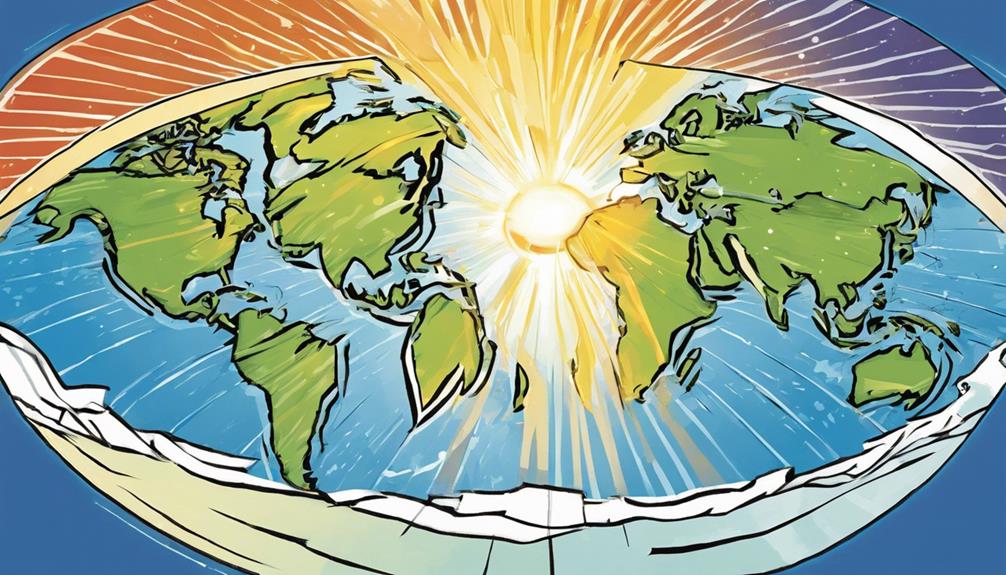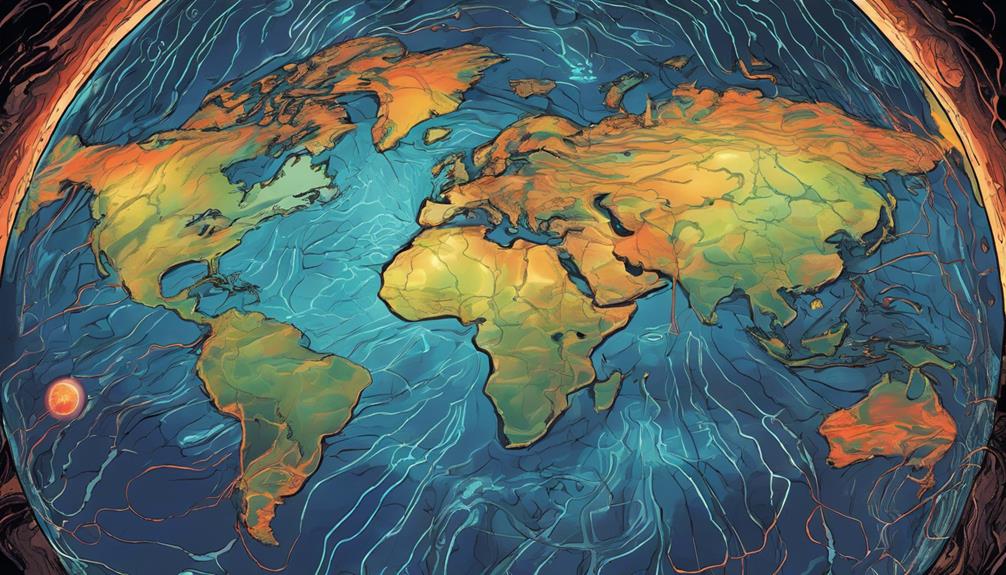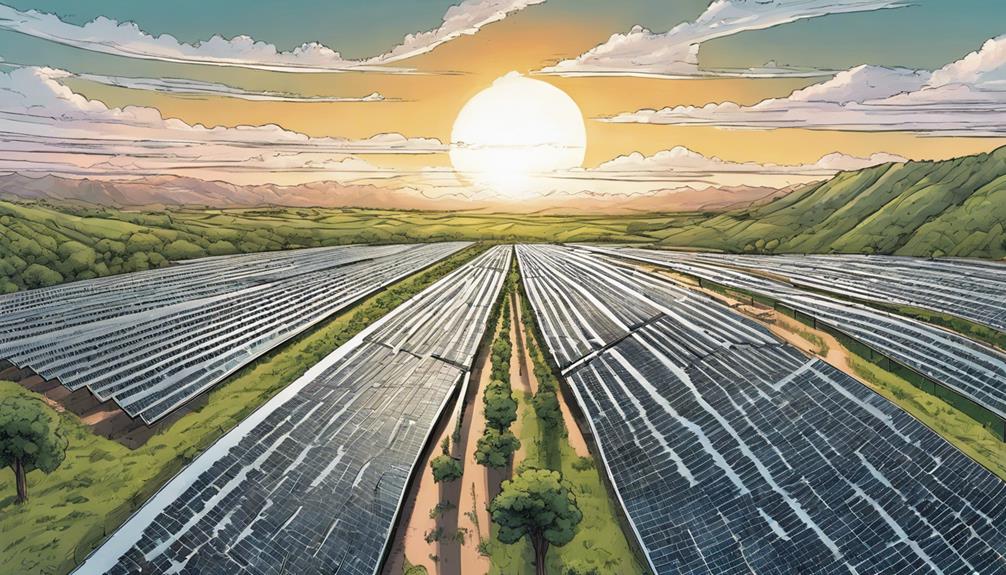I've found that the uneven distribution of solar energy across latitudes is primarily driven by Earth's 23.5-degree tilt. This tilt causes variations in solar radiation patterns, with the sun's angle changing throughout the year. As a result, higher latitudes receive less solar energy due to more extreme sun angles, while the equator receives more with less pronounced angle changes. But that's not all – atmospheric circulation patterns, cloud cover, surface albedo, and seasonal variations also play a role in shaping these disparities. As I explore these factors further, I'm discovering just how complex and fascinating this topic is.
Key Takeaways
- Earth's 23.5-degree tilt causes variations in solar radiation patterns, resulting in disparities in solar energy across latitudes.
- Higher latitudes receive less solar energy due to more extreme Sun angles, reducing energy absorption.
- The equator receives more solar energy with less pronounced angle changes, resulting in increased energy absorption.
- Atmospheric circulation patterns, such as trade winds and prevailing westerlies, redirect and channel solar energy towards specific latitudes.
- Surface albedo and cloud cover regulate solar energy absorption or reflection, further contributing to disparities across latitudes.
Earth's Tilt and Sun Angles

As I stand on Earth's surface, I'm reminded that its 23.5-degree tilt is the primary driver of variations in solar radiation patterns, which in turn affect the amount of solar energy we receive.
This tilt, known as obliquity, causes the Sun's angle to change throughout the year, resulting in varying amounts of solar energy reception. At higher latitudes, the Sun's angle is more extreme, leading to less solar energy reception. In contrast, the equator receives more solar energy due to less pronounced angle changes.
Understanding Earth's tilt is essential for studying climate and weather patterns, as it has a significant impact on the distribution of solar energy across different latitudes.
Atmospheric Circulation Patterns

Driven by Earth's rotation and temperature differences, atmospheric circulation patterns emerge, shaping the distribution of solar energy across the globe. As I explore the intricacies of these patterns, I'm struck by their significant impact on our climate. Trade winds, prevailing westerlies, and polar easterlies form, influencing the movement of air masses and, subsequently, solar energy distribution. Ocean currents, propelled by wind patterns and temperature differences, transport warm and cold water, further impacting coastal climates.
| Wind Pattern | Effect on Solar Energy |
|---|---|
| Trade winds | Redirects solar energy towards the equator |
| Prevailing westerlies | Channels solar energy towards mid-latitudes |
| Polar easterlies | Limits solar energy reception at high latitudes |
Understanding these patterns is essential for comprehending the differences in solar energy reception across latitudes.
Cloud Cover and Its Effects

I find that clouds, those puffy white masses in the sky, play an important role in regulating the amount of solar energy that reaches the Earth's surface, and their varying types and coverages greatly impact regional temperatures and climate patterns. Low-lying clouds trap heat, leading to warmer temperatures, while high-level clouds reflect sunlight, reducing solar radiation.
Clouds also interact with aerosols, affecting solar radiation variability. Additionally, cloud cover influences regional climate and weather patterns, making it a vital factor in climate change predictions. Understanding cloud cover is essential for accurately modeling climate patterns and predicting changes.
Surface Albedo and Reflection

The amount of solar energy absorbed or reflected by the Earth's surface is regulated by surface albedo, which varies greatly depending on the type of surface, with different materials and vegetation having distinct reflection coefficients.
As I explore the world of surface albedo, I realize that it's an essential factor in determining the amount of solar energy that's absorbed or reflected. Vegetation, for instance, absorbs more solar energy than it reflects, leading to higher temperatures in areas with high vegetation cover. On the other hand, surfaces like snow and ice have high reflection coefficients, reflecting most of the solar energy they receive.
Understanding surface albedo is crucial for climate modeling, as it helps us predict how different surfaces respond to solar energy.
Seasonal Variations in Sunlight

As I bask in the warmth of summer or shiver through the chill of winter, I'm reminded that seasonal variations have a significant impact on the amount of sunlight we receive. The changing angle of the sun throughout the year affects the distribution of solar energy across latitudes. This, in turn, influences various aspects of our lives.
Here are three key ways seasonal variations impact us:
- Agricultural productivity: More sunlight means increased plant growth and higher crop yields.
- Vitamin D levels: Sunlight is a natural source of vitamin D, essential for human health.
- Circadian rhythm and mood: Exposure to sunlight helps regulate our internal clock and boosts our mood.
Understanding these seasonal variations is essential for harnessing solar energy and mitigating its disparities across latitudes.
Frequently Asked Questions
How Does Solar Energy Impact Urban Heat Island Effects in Cities?
As I explore how solar energy affects urban heat island effects, I realize that higher latitudes receive less direct sunlight, leading to reduced heat absorption, whereas cities near the equator experience more intense solar radiation, exacerbating urban heat islands.
Do Mountains and Valleys Affect Local Solar Energy Reception Patterns?
"I recall hiking in the Rockies, where valleys received more direct sunlight than mountains. Similarly, mountains and valleys affect local solar energy reception patterns, with valleys receiving more intense sunlight due to their lower elevations."
Can Human Activities Influence Regional Solar Energy Distribution Patterns?
I think human activities can influence regional solar energy distribution patterns, particularly through land use changes, urbanization, and aerosol emissions, which can alter cloud cover and surface albedo, impacting local solar radiation.
How Does Solar Energy Affect the Earth's Water Cycle and Precipitation?
"I'm curious about how solar energy impacts the Earth's water cycle and precipitation. It seems that solar radiation evaporates water, which eventually condenses into clouds, influencing precipitation patterns and regional climate conditions."
Are There Any Solar Energy Disparities Between Coastal and Inland Regions?
As I wander between the coast and inland, I notice the sun's warm touch varying like a gentle lover's caress – coastal regions bask in the direct rays, while inland areas receive a softer, more scattered glow.
How Do Solar Energy Disparities Across Latitudes Impact Global Efforts to Expand Solar Energy Access?
The disparities in solar energy across latitudes can significantly impact global efforts to help countries elevate solar energy. As regions closer to the equator have more consistent sunlight, they have a natural advantage in harnessing solar power. This can create challenges for countries at higher latitudes trying to expand solar energy access.
Conclusion
As I wrap up this journey into the heart of solar energy disparities, I'm reminded of the ancient Greek aphorism 'know thyself' – but in this case, it's 'know thy planet.'
By grasping the intricacies of Earth's tilt, atmospheric circulation, cloud cover, surface albedo, and seasonal variations, we can harness the power of the sun like a skilled conductor leading an orchestra.
The rhythm of our planet's energy dynamics is complex, but with knowledge, we can harmonize human progress with the natural world.










